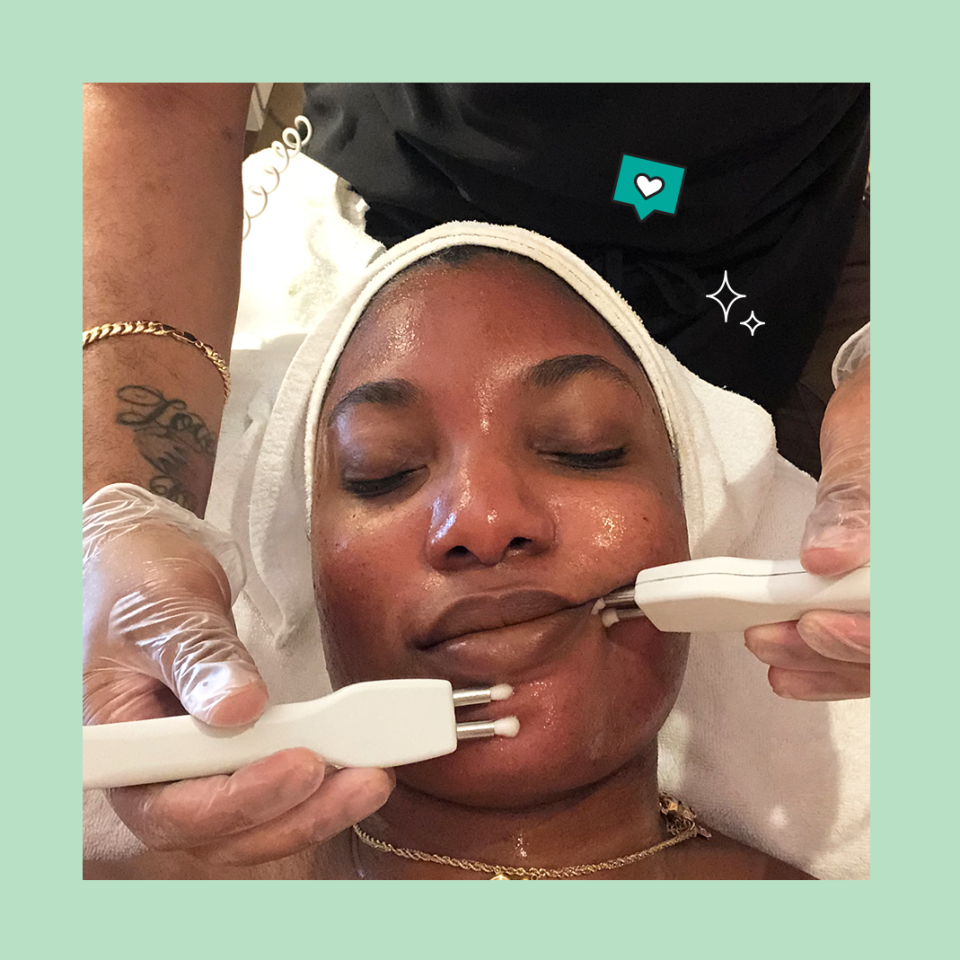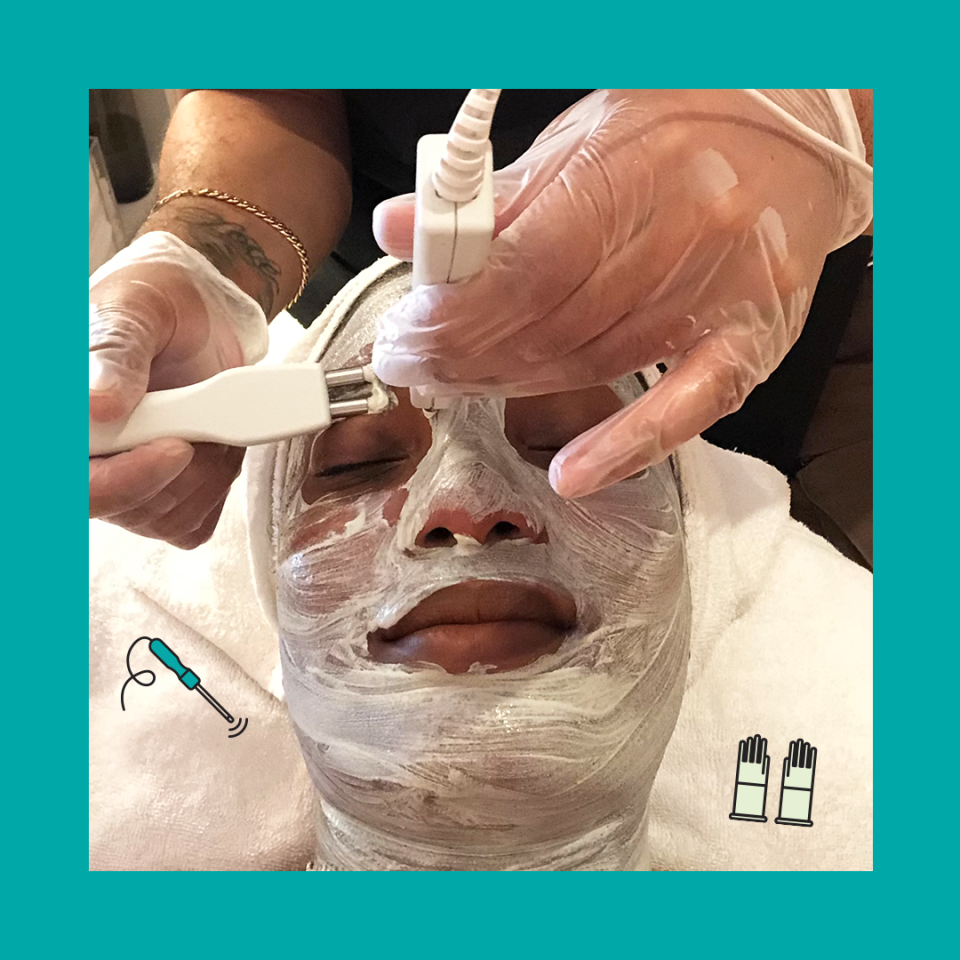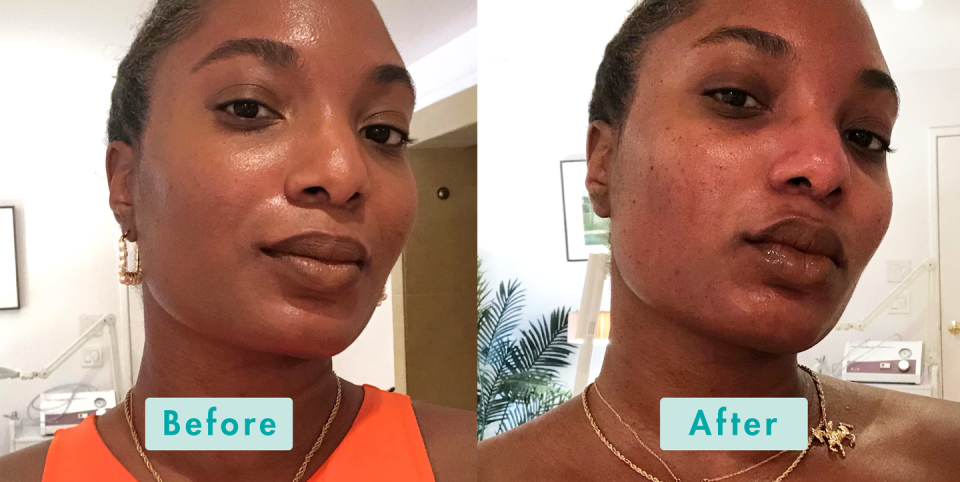I Got a Microcurrent Facial and My Skin Looks Freakin' Excellent
“Hearst Magazines and Verizon Media may earn commission or revenue on some items through the links below.”
Even as someone who writes about beauty, I can't say I've really gotten the hype around facials. It wasn't until I had my first microcurrent treatment—a technology that uses a low-grade electrical current to help tighten your facial muscles and smooth your skin—that I realized maybe I've been a little too hard on the whole facial thing (like, so what if I prefer a 45-minute session with the hum of a machine in the background to a quiet, candlelit experience at a spa?).
For those of you new to the micocurrent game, you can think of it like a workout for your face. After a few sessions, the non-invasive treatment is said to help sculpt your face, tighten your skin, and even stimulate collagen production—no irritation, pain, or downtime included, tyvm. Sounds kinda incredible, right?
It's got some pretty impressive history behind it too: The use of microcurrent technology was introduced to the world of medicine in the 1980s and was the first FDA-approved treatment for Bell's palsy and muscle paralysis. Decades later, microcurrent is now a part of many facial services offered throughout the skincare community—including celebrity aesthetician Joanna Vargas' Los Angeles spa, where I tried out the treatment myself.
And, like, not to completely spoil the results, but let me just say that after one session, I was left with skin so glowy I got stopped on the street (I mean, my before-and-after pics don't lie). Down to learn more about it? Keep scrolling for your ultimate guide to microcurrent facials, including my legit results, what two derms actually think about the treatment, and so much more.
What is a microcurrent facial?
One more time for the ppl in the back: Microcurrent facials are basically like a workout for your face—meaning they help stimulate your facial muscles. Microcurrent facials are often combined with other treatments too, like Vargas' Triple Crown Facial, which calls on microdermabrasion for exfoliation, microcurrent for lifting, and oxygen-infused therapy for hydration (she says it's especially great before weddings and red-carpet appearances, which is probably why she works with celeb clients like Julianne Moore and Constance Wu).
"I use electricity to drain out excess water, tighten the muscles, and tighten the skin to make the jaw and cheeks look tight, lifted, and youthful," she says. Vargas adds that by the end of one treatment, the jawline and cheekbones already look more defined, but as with any workout, she says the best results show after a handful of sessions. But even as the trendy treatment gains popularity, there are still limited studies on the use of microcurrent in cosmetic settings, which brings me to...
Does microcurrent therapy work?
John Diaz, MD, plastic surgeon and cofounder of Honor MD, doesn't find microcurrent to be an effective treatment to get more lifted and defined facial features. “The idea behind the microcurrent facial is that electrical stimulation of the muscles will build them up and result in a more lifted and chiseled appearance of the face," he says. "Although electricity can stimulate muscles to contract, simple contraction of the muscle does not build it up or tighten it. Muscle needs resistance, usually in the form of weight, to actually build new muscle cells or strengthen existing ones."
Miami-based dermatologist Loretta Ciraldo, MD, has a slightly different point of view on microcurrent therapy. Even though she doesn't think microcurrent has the longevity of other treatments (like injectables), she does believe microcurrent can provide some benefits for those in their 20s and early 30s before the skin loses elasticity and tone.
One of the reasons microcurrent technology is sought after? It's said to help boost collagen (something we lose over time as we age), which Dr. Diaz says is a possibility. "Microcurrent treatment likely increases blood flow," he says, which is why patients report looking "plumper" after they get treated. But Dr. Diaz notes that increased blood flow combined with proper nutrition, health, and skincare can also aid in the boost of collagen. That means microcurrent therapy is unlikely to boost collagen by itself, he says. "Instead, collagen may be boosted through a combination of treatments."
What happens during a microcurrent facial?

My service started with a quick cleanse to remove my makeup before master aesthetician Shane—who I learned grew up right down the street from me in Atlanta, small world!—took a look at my skin under a magnifying glass. He told me what I often hear from dermatologists and aestheticians: My skin has some congestion, dead skin buildup, and of course, hyperpigmentation—a few of the woes that come along with having combination, melanin-rich skin.
Next up was a quick microdermabrasion session with a diamond-tipped wand to gently—but effectively—exfoliate my skin. After my face was primed and ready for the main event, I asked Shane if I should expect any pain during the microcurrent process. With a little laugh, he said no, which immediately eased my anxiety. As Shane moved the dual-pronged device along on my skin, I felt basically nothing—no pain or discomfort. Imagine gently pressing a facial sculptor (like a jade roller) into your face for a few seconds at a time.

After finishing the left side of my face, Shane handed me a mirror to look at the results. I was pleasantly surprised—it was definitely subtle, but my skin already looked a bit tighter and smoother. After the first round of microcurrent, Shane applied a mask and went over my face once more before removing the remaining product with a warm towel. Then, my skin got a boost of hydration with oxygen therapy, followed by a few layers of hydrating face serums and a red LED light session (which, for the record, is used to help promote circulation).
After my facial was over, my skin seriously glowed. I felt super refreshed—almost like I’d just come back from a month-long vacation—and my skin looked noticeably smoother (which, TBH, was probably from the microdermabrasion aspect of my treatment). The biggest difference I noticed from the microcurrent? My face looked less puffy and a bit more defined, especially under my eyes and around my cheekbones.
Is there any downtime?
Since microcurrent therapy is gentle—remember: it's a non-invasive treatment and it works the muscles under your skin—you shouldn't expect any redness or inflammation. But since my treatment also included some microdermabrasion, I did experience a little sensitivity post-treatment. My fix? I used only hydrating products and paused my active ingredients for a few days following my appointment just to be safe.
How long does it take to see results?
Here's the thing: I can't report that I had a super-drastic lift following my microcurrent facial. I did notice that de-puffing under my eyes and around my cheekbone lasted for a few days post-facial though, but as Vargas explains, microcurrent therapy is most effective when it's done regularly. "[It is a] long term [commitment], just like the gym. Most of my clients like to come every three to four weeks to really get the cumulative benefit," she explains.

Are microcurrent facials safe?
For the most part, microcurrent treatments are safe for everyone. However, Dr. Diaz says some may want to proceed with caution. "Fortunately, this treatment is overall very safe, since the devices produce a low amount of electrical current," he explains. "That said, it's probably wise to avoid this treatment if you have certain heart conditions that are affected by electrical changes." If that's you, you'll want to consult with your physician prior to getting a microcurrennt facial, he says.
One more thing to keep in mind: If you get Botox or fillers, Dr. Ciraldo says you'll want to wait two weeks before trying microcurrent therapy (at-home or in-office). Not giving your skin enough time to settle could potentially move your Botox from its intended injection site, so always give yourself a full two weeks before you do anything, k?
How much does a microcurrent facial cost?
The exact cost of your facial will depend on your location and aesthetician (and keep in mind that microcurrent is usually paired with other facial treatments, which can also affect your price point). Typically, you can expect to spend somewhere between $250 to $500 per session.
Can you try microcurrent therapy at home?
As with most skincare treatments, there are at-home microcurrent devices, but they aren't going to give you the same effects as an in-office treatment. Still, at-home devices are a great option for anyone looking to regularly treat their skin to microcurrent technology (you've probably heard of NuFace—or at least seen it on your IG feed—which is one of the most popular devices on the market right now). These picks are a great place to get started:
The final word

I definitely enjoyed my microcurrent facial as a whole. And thanks to the fact that it was also combined with exfoliating and hydrating benefits, I felt like my skin really glowed post-appointment. As someone who isn't into fillers (although I am pro doing whatever makes you feel your best!), I love the idea of a treatment that can help me get similar, lifted results without the needles or invasive procedures. TL;DR: I'd 100 percent try it again.
You Might Also Like

